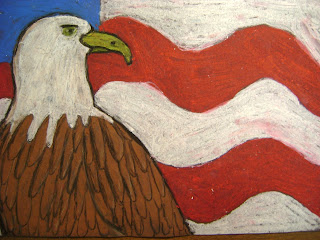This is a GREAT end of the year project when you need something fun. I like to use this project to teach abstract art, cubism, and about the artist Pablo Picasso.
Some students LOVE this project, some students HATE it! But we all giggle and have FUN! Those that do not like the results are typically the students who think it's "weird" and do not like abstract art, or being pushed out of their comfort zone. Talk to your students before you begin and explain that this will be something they have probably never done before! Tell them that some will like the adventure and some may not feel it is their cup of tea, but to just go with the flow because the process is really fun and unique! The best part? If you make a mistake, NO ONE WILL BE ABLE TO TELL! hee hee!
Can you guess what each animal is? (HINT: the one below this is a kangaroo! the one above is a bird!)
I tell students to imagine an animal they would like to create. (They still have no idea what we are doing or where we are headed! However, we have looked at Picasso's work prior to the project via PowerPoint.)
I tell them to close their eyes and imagine their animal. "What does it's snout look like? What does it's feet look like? How about its tail? What does it's ears look like? Does it have fur or scales?" Etc.
We begin with a 12x12" square paper.
I demo each step first then have students follow.
Using a pencil we begin the process as follows:
Step 1: Draw an eye anywhere on your paper
Step 2: Turn your paper once to the right. Now draw a second eye, several times LARGER than the first!
Step 3: Turn your paper once more to the right. Now draw the snout of your animal.
Step 4: Turn your paper again to the right. Now draw ONE foot (and leg)
Step 5: Turn again to the right. Here I have students draw one ear.
Step 6: Turn paper again to the right. Draw another foot!
Step 6: Turn paper again to the right. Draw the other ear!
Step 7: Turn paper one more time. Draw the tail.
Step 8: Turn paper one last time to the right. It should now be back to the beginning. At this step, students have to figure out how to connect all the pieces to create a body!
We then outline with sharpie. Everyone is giggling at this point!
The last stage is to add color. We use crayons to color the animals. And I have students create a pattern in the background using crayon as well. When done, students choose one color (liquid watercolor) to paint the background. This is also teaching wax resist and the wet-on-wet watercolor technique! We also added salt to the watercolor background for another fun twist :)
VIOLA! Always a class favorite!





















































